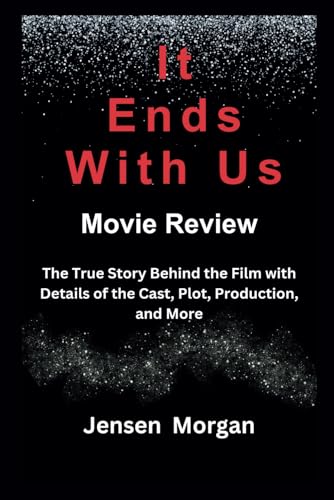Alright, folks, it’s time for my honest, totally-not-paid-off review of the much talked about ‘It Ends With Us’. If you wondered how a book packed with big feelings and even bigger plot twists holds up on the big screen, you’re in the right place. I read the book, dragged my friends to the movie, and yes, I brought tissues (for dramatic effect, of course). In this review, I’ll break down the accuracy of the characters, the cast’s acting chops, how true it stays to the novel, and which moments hit the hardest. Buckle up—I promise to keep it real, a bit funny, and maybe even a little helpful if you’re thinking about spending your hard-earned popcorn money.
It Ends With Us by Colleen Hoover: A Book Review
In a nutsheel
Colleen Hoover wrote It Ends With Us, a book that falls in the romance genre but feels much deeper. This is not just about smooches and first dates. Nope. It’s got tough topics like strength, love, and making choices when things get tough. The main character, Lily, faces some real hard times, and the story shows how our past affects our future. If you like emotional stories that make you think “wow, life is messy,” this one’s for you. Don’t worry, I won’t spill any big secrets!
How True Are The Characters from ‘It Ends With Us’ in the Movie?
Alright, folks, let’s talk about character accuracy in the ‘It Ends With Us’ movie. Now, when I read Colleen Hoover’s book, Lily felt like someone I’d meet at the local coffee shop—full of hope, stubbornness, and just a sprinkle of awkwardness. In the movie, they really tried to stick true to her. She even rocks the same color hair as on the cover! But, let me tell you, a killer hairstyle does not always mean a perfect match. I missed some of Lily’s inner dialogue. I mean, her thoughts in the book are like my own when I accidentally buy decaf—confused and dramatic. The film shows her softer moments, but sometimes skips the fire she has when she’s under pressure.
Now, Ryle. The book’s Ryle is a puzzle—good looking, charming, but with a fuse shorter than my patience in traffic. The movie does capture that charm; my friends even sighed every time he was on screen. But his darker sides? Not as fleshed out. The balance between caring surgeon and someone who loses control felt a bit quick, almost like they read the Cliffs Notes instead of the whole book.
Atlas—oh Atlas!—in the book, he’s like your favorite hoodie: reliable and just the right fit. The movie? They sometimes treat him more like a background character than the heart of Lily’s past. It’s not a trainwreck, but I wanted more.
Stick around, because up next I’ll spill the beans about who they cast in these roles and whether they could actually, you know, act!
Casting Choices and Actor Performances in ‘It Ends With Us’
Alright folks, let’s talk about casting! When I first heard about the cast for the ‘It Ends With Us’ movie, I did the thing where I pretend not to care, but secretly scroll for hours. It’s a big deal—get it wrong, and you’ll have fans staging a protest at your local coffee shop. I was rooting for the right balance. Lily needed someone who could show both strength and vulnerability (and also rock red hair, obviously). I watched the movie with friends who all said, “Hey, that’s actually how I pictured her!” Score one for the casting folks.
Ryle’s actor? I was scared he’d look too much like a soap opera villain, but the performance struck a balance between charming and, well, a little scary. My buddy Dave kept pausing the movie and saying, “I don’t trust that guy’s smile.” That’s how you know it’s working! Atlas’s actor brought a calm, steady presence to the chaos. The chemistry between the leads felt real—not forced, which can happen when the studio just casts the two biggest names they can find.
Sure, a couple of the supporting roles felt like afterthoughts. I’m still scratching my head over one best friend who seemed to appear out of nowhere, say three lines, then vanish forever. But overall, the casting added a lot to my enjoyment in this it ends with us review. Up next: I’ll be talking about faithfulness to the original novel—so get ready to see if your favorite scenes made the cut or got chopped!
How True Is the Movie to Colleen Hoover’s Story?
If you’re a fan of Colleen Hoover’s emotional rollercoaster, you’re probably wondering if the movie adaptation sticks to the same tracks as the book. In this ‘It Ends With Us review,’ I paid close attention to how well the film follows the twists, turns, and heartfelt lessons of the original novel. First, I noticed that most major plot points were faithfully adapted. The big reveals and tough decisions were not lost in translation. For the most part, the scriptwriters respected the spirit of the source material, only trimming a few scenes for time. You won’t see any wild detours or odd changes that make you throw your popcorn in protest.
But let’s not gloss over a few creative liberties. The movie softens or skips some internal monologue, meaning we don’t always get Lily’s inner thoughts as deeply as we did while reading. Sometimes, things that took pages of reflection in the book get summed up in a single look between the actors. As a reader, I missed a bit of the backstory and little details—like Lily’s passion for her flower shop, which didn’t get much screen time. That said, the heart of the story is still beating strong. The themes of love, bravery, and making hard choices all survive the jump to the big screen.
Overall, this adaptation keeps true to Colleen Hoover’s original intent, even if it skips a few petals on the way. Next up, let’s break out the tissues and talk about the key emotional moments that stuck with me long after the credits rolled!
Heartstrings and Waterworks: The Key Emotional Moments in ‘It Ends With Us’ Review
Okay, let me grab my tissues and tell you about the emotional rollercoaster that is ‘It Ends With Us’. Seriously, this film knew just how to punch me in the feels—the same way my cat knocks my coffee off the table at 7am. I promised not to talk about the character accuracy or casting again (scout’s honor!), so let’s zero in on those gut-punch moments that make or break a good cry sesh.
First, there’s the scene where Lily stands her ground. I got goosebumps watching her, even though my popcorn was getting cold by then. You can see the pain in her eyes, but you also spot the fire. It’s raw, not sugar-coated, and I wanted to reach into the screen and hand her some chocolate. In my group chat, we all agreed this bit felt genuine—and that’s rare in Hollywood’s world of over-the-top drama.
Next, let’s chat about the flashbacks. Usually, flashbacks confuse me (I once thought I was watching a different movie altogether), but here, they just work. They let you peek into Lily’s past traumas without dragging. The way Atlas gives Lily hope is heartwarming. I’m not blushing—you’re blushing!
The ending? If you don’t tear up, you might be a robot. It’s bittersweet and hopeful. Real life is messy, and the film nails that.
So, do I recommend this movie after watching and chatting about it? You bet! Grab snacks, tissues, and maybe your best friend—this one’s worth the emotional ride.
Conclusion
Well, that wraps up my review of “It Ends With Us”. If you want a story that hits you right in the feels, this book pulls it off. The characters are messily human, the story keeps you hooked, and it spares no punches with the heavy stuff. I had to take a break and hug my dog, honestly. Still, it’s not perfect—some scenes are a bit dramatic, and the romance can get a bit cheesy. But hey, isn’t life a little cheesy sometimes? Overall, Colleen Hoover nails a tough subject in a real way. If you like strong heroines, hard choices, and some teary eyes, give this book a shot. That’s my two cents, and my dog agrees. Review over—now go read something good!



